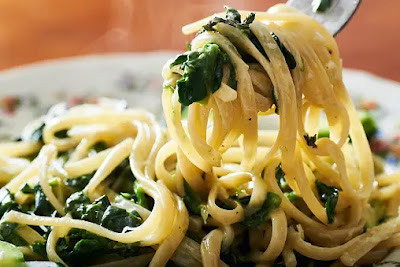Spinach pasta is a delicious and healthy meal that is perfect for any occasion. It is made with fresh spinach, pasta, and your favorite sauce. Spinach is a good source of vitamins A, C, and K, as well as fiber. It is also low in calories and fat. This recipe is easy to make and can be customized to your liking. You can use any type of pasta, sauce, or cheese that you like. For a healthier option, you can use whole-wheat pasta or a light sauce. Spinach pasta is a great way to get your daily dose of vegetables. It is also a good source of protein and fiber. This meal is sure to satisfy your hunger and keep you feeling full for hours.
Spinach pasta is a delectable dish that combines the nutritional goodness of spinach with the comforting flavors of pasta. This vibrant and nutritious meal not only satisfies your taste buds but also offers a wide array of health benefits. In this article, we will delve into the world of spinach pasta, exploring its nutritional profile, health advantages, and tips for incorporating it into your diet. Spinach pasta offers a vibrant and nutritious twist to traditional pasta dishes. Packed with the goodness of spinach, this pasta is not only visually appealing but also incredibly delicious. Here's a recipe to create a delightful spinach pasta:
Ingredients:
- 8 ounces of your favorite pasta (e.g., fusilli, farfalle,
tagliatelle)
- 4 cups fresh spinach leaves, washed and stemmed
- 2 tablespoons olive oil
- 3 cloves of garlic, minced
- Red pepper flakes (optional)
- Salt and pepper to taste
- Grated Parmesan cheese for garnish
Instructions:
1. Cook the pasta according to the package instructions
until al dente. Drain and set aside.
2. In a large skillet, heat the olive oil over medium heat.
3. Add the minced garlic and sauté until fragrant, about 1
minute.
4. Add the fresh spinach leaves to the skillet and cook
until wilted, stirring occasionally.
5. If desired, sprinkle in some red pepper flakes for a
touch of heat.
6. Season with salt and pepper to taste.
7. Transfer the cooked spinach and garlic mixture to a
blender or food processor.
8. Blend until smooth, creating a vibrant green spinach
sauce.
9. Return the sauce to the skillet and heat over low heat.
10. Add the cooked pasta to the skillet and toss until it is
well coated in the creamy spinach sauce.
11. Transfer the spinach pasta to serving plates.
12. Sprinkle grated Parmesan cheese on top for a delightful
finishing touch.
13. Serve hot and enjoy the vibrant flavors and nutritional
benefits of spinach pasta.
Nutritional Benefits of Spinach Pasta:
- Rich
in Essential Nutrients: Spinach, the star ingredient of spinach pasta, is
a nutrient powerhouse. It is packed with essential vitamins and minerals,
including vitamin A, vitamin C, vitamin K, folate, iron, and magnesium.
These nutrients play crucial roles in supporting overall health and
well-being.
- Excellent
Source of Fiber: Spinach pasta provides a good amount of dietary fiber,
thanks to the inclusion of spinach and whole-grain pasta. Fiber aids in
digestion, promotes satiety, and helps regulate blood sugar levels. It
also supports a healthy gut microbiome and can contribute to weight
management.
- Abundant
in Antioxidants: Spinach is rich in antioxidants like vitamin C, vitamin
E, and beta-carotene. These antioxidants help combat oxidative stress and
protect the body's cells from damage caused by harmful free radicals.
Regular consumption of spinach pasta may contribute to a reduced risk of
chronic diseases, including heart disease and certain cancers.
- Promotes
Bone Health: Spinach contains high levels of vitamin K, which is essential
for bone health and plays a vital role in calcium metabolism. Adequate
vitamin K intake can help improve bone density and reduce the risk of
fractures, making spinach pasta a beneficial choice for bone health.
- Supports
Vision and Eye Health: The presence of lutein and zeaxanthin, two
antioxidants found in spinach, contributes to maintaining healthy vision.
These compounds help protect the eyes from age-related macular
degeneration and cataracts, promoting long-term eye health.
- Heart-Healthy
Properties: Spinach is low in calories and fat while being rich in
nutrients that support heart health. The combination of fiber, vitamins,
and minerals in spinach pasta can help lower cholesterol levels, maintain
healthy blood pressure, and reduce the risk of cardiovascular diseases.
- Provides
Plant-Based Protein: While spinach is not a significant source of protein,
it still contributes a fair amount to the overall protein content of
spinach pasta. Adding other protein sources such as beans, lentils, or
grilled chicken can enhance the protein profile and create a balanced
meal.
- Boosts Immune Function: The vitamins and antioxidants present in spinach contribute to a robust immune system. Vitamin C helps support immune function, while other antioxidants strengthen the body's defense against infections and illness.
Incorporating Spinach Pasta into Your Diet:
- Pair
with Whole-Grain Pasta: Opt for whole-grain pasta instead of refined
varieties to increase the fiber content and enhance the nutritional value
of your spinach pasta. Whole grains offer additional health benefits and
contribute to a more balanced meal.
- Experiment
with Homemade Sauces: Create homemade sauces for your spinach pasta using
fresh ingredients and herbs. Tomato-based sauces with garlic and herbs,
light cream-based sauces, or olive oil-based dressings with lemon zest can
complement the flavors of spinach while keeping the dish nutritious.
- Add
Protein and Vegetables: Enhance the nutritional profile of your spinach
pasta by incorporating lean proteins such as grilled chicken, shrimp, or
tofu. Additionally, consider adding a variety of colorful vegetables like
cherry tomatoes, roasted bell peppers, or sautéed mushrooms for added
nutrients and flavors.
- Balance
Portions: While spinach pasta is nutritious, it's essential to maintain
portion control to ensure a balanced meal. Be mindful of the quantity of
pasta and consider filling your plate with a generous serving of spinach
and vegetable toppings.











